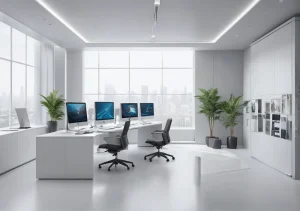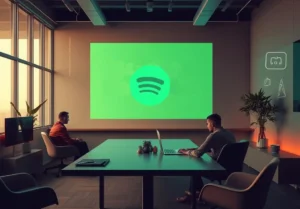You’re about to walk through the doors of Microsoft’s headquarters, palms sweaty with a resume that’s been polished until it gleams. The onsite interview is the boss level in the game of tech job hunts, where stakes are high and the final boss – the infamous whiteboard – awaits. You’re in the right spot to find out exactly what awaits you in that meeting room.
This blog post will equip you with a keen understanding of the Microsoft onsite interview format, so you can step through those doors with confidence, knowing what to expect.
Quick Takeaways:
- Master the Microsoft interview process by practicing coding problems, studying system design, and becoming familiar with Azure and related technologies.
- Use the STAR method to answer behavioral questions, showing how you align with Microsoft’s culture of teamwork and growth.
- Make a lasting impression through strong non-verbal communication, insightful questions, and demonstrating genuine enthusiasm for the role and Microsoft’s mission.
What Can You Expect During Your Microsoft Onsite Interview?
When you’re gearing up for your interview at Microsoft, knowing what’s in store can help settle those pre-interview jitters. Your onsite interview typically follows a successful phone or virtual preliminary screening. The rhythm of the day is orchestrated to assess your skills across a broad spectrum. So let’s walk you through it!
First things first, you’ll kick off with a meet-and-greet. This is your chance to make a smashing first impression. You’ll be meeting with the interview panel or a hiring manager and get a brief overview of the day.
Now, down to the nitty-gritty. Candidates can expect a series of interviews focusing on different areas:
- Technical Rounds: Coding conundrums and algorithmic puzzles will be thrown your way. They aren’t just testing your technical know-how but also your problem-solving approach.
- Coding Challenges: You’ll need to demonstrate your coding skills in real-time. This could be pen and paper or on a computer, depending on the role.
- System Design Interviews: Here’s where you showcase your ability to design complex systems, discussing scalability, data flow, and architecture.
- Behavioral Interviews: It’s all about your soft skills and how well you play with others.
Expect the interview process to span several hours—usually a full working day. Schedule flexibility and pacing yourself for this marathon are key!
How Should You Prepare for the Technical Challenges?
Preparing for the onslaught of technical questions Microsoft will throw at you requires strategy. Here are a few tips that might just give you the edge:
- Master fundamental concepts: Thoroughly understand data structures and algorithms.
- Practice coding questions: Websites like LeetCode or HackerRank are your friends.
- Deep dive into system design: Get comfy with concepts like load balancing, caching, and database indexing.
- Familiarize yourself with Microsoft’s tools: Have a grasp of technologies like Azure, and even the languages predominantly used by the team you’re interviewing with.
Now, here’s a hidden gem: pay attention to the nuances of the role you applied for. For instance, if you’re interviewing for a position involving cloud services, being savvy about Azure’s specific capabilities can set you apart from the competition.
What’s the Deal with Behavioral Questions?
Ah, behavioral questions. If you think they’re just filler material, think again. These questions can be the deciding factor between candidates with similar technical prowess. Microsoft wants to see how you’d mesh with their culture and handle real-world scenarios.
Expect queries like:
- Tell me about a time you faced a significant challenge at work. How did you overcome it?
- Describe a situation where you had to work with a difficult colleague.
Your secret sauce here is the STAR method. This simple, structured approach ensures your answers are crisp and potent:
- Situation: Set the stage. Briefly describe the context.
- Task: Explain the problem or challenge you were facing.
- Action: Dive into the specifics of what you did to address the task.
- Result: Highlight the outcomes of your actions.
Emphasize outcomes where your contribution had a measurable impact. Remember, stories resonate, so share experiences that showcase a rich blend of skills—teamwork, communication, leadership, and resilience.
And here’s a tip that’s gold—don’t just talk about what you did; reflect on what you learned. It shows depth and a growth mindset, and it’s something not everyone remembers to include.
These insights should help you to not just survive, but thrive in a Microsoft onsite interview. Keep things real, be yourself, prepare diligently, and go show them what you’re made of!
How Can You Make a Lasting Impression?
Leaving a strong impression at an interview goes beyond just showcasing your technical chops. You’ve got to connect with your interviewers on a human level, too. Here’s how you can stick in their minds long after the handshake.
Be Mindful of the Non-verbals: Your posture speaks volumes before you even utter a word. Stand tall, nail that confident yet friendly handshake, and maintain good eye contact. A slouch may suggest a lack of confidence, while sustained, natural eye contact can show you’re engaged and present.
Get the Etiquette Right: Politeness never goes out of style. A ‘thank you’ when appropriate and being attentive when others speak is crucial. It’s the little things – like not interrupting and showing appreciation for the interviewer’s time – that polish your image.
Curate Your Questions Wisely: Once it’s your turn to ask questions, make them count. Inquire about the team’s biggest challenges, or what success looks like in the role – questions that show you’re already invested in contributing positively.
Convey Genuine Enthusiasm: Let your passion for the role and the company culture shine through. An offhand comment about a recent Microsoft initiative or expressing excitement about contributing to the company’s mission can demonstrate your sincere interest.
Remember, it’s not just what you say; it’s also how you say it. Your final impression is a mix of qualification and connection. When you leave that room, you want them to think, “This is someone we need, and want, on our team.”
Any Insider Tips on the Microsoft Interview Culture?
Microsoft is known for valuing innovative and driven individuals who are willing to learn and collaborate. To tread water in their interview culture, you’ll need to paddle in sync with these values.
Know Their Mission: Microsoft’s mission is to empower every person and every organization on the planet to achieve more. Understanding and aligning with this mission can give you an edge. Explain how your personal goals dovetail with this global vision.
Adaptability is Key: Show that you’re not just a one-trick pony but someone with a growth mindset. Tell a story about a time when you had to adapt to change or learn something new on the fly.
Cultural Fit Matters: Microsoft cherishes a culture where diversity and inclusion are non-negotiable. Prepare examples of how you’ve worked effectively in diverse teams or contributed to inclusive environments.
And here’s something you might not hear often: Pay attention to how your interviewers interact with each other. It can give you a sneak peek into the team dynamics and help you tailor your responses.
By demonstrating your ability to blend into Microsoft’s culture, you not only show that you’re a solid candidate for the job but also someone who could thrive and evolve within the company. Remember, at Microsoft, it’s about more than fitting the role today – it’s about shaping the role tomorrow.
Combining these insights with a powerful first and last impression could very well be your ticket to not just an offer, but a fulfilling career at Microsoft. Good luck, and go show ’em what you’ve got!


